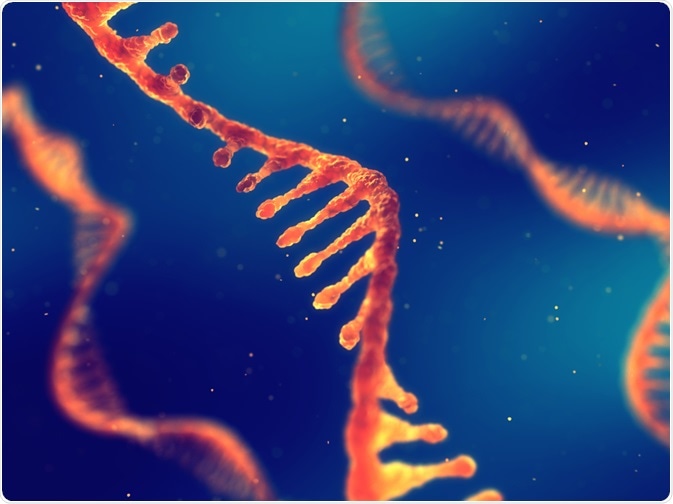“Sugar-coated RNA” is a term that was coined after a pre-printed article last year reported that some sugars seem to bind to RNAs, molecules that carry DNA instruction for protein synthesis and catalyze chemical reactions.
 Image Credits: nobeastsofierce / Shutterstock.com
Image Credits: nobeastsofierce / Shutterstock.com
The study, which is the first to introduce the notion of sugar-coated or glycosylated RNAs, is available in the preprint server bioRxiv and has not yet been peer-reviewed.
The discovery of what study author, Carolyn Bertozzi, refers to as a “weird hybrid biopolymer” immediately grabbed the attention of the scientific community, with people referring to it on Twitter as a “profound observation” that was “mind-blowing” and a sign that a “new era is starting.”
Why were the findings so surprising?
Researchers have already established that RNAs can be modified by other molecules, and almost 200 chemical modifications have been identified that change its function or direct it to one cellular compartment over another. However, no one has previously suggested that complex sugars could do this and since the findings were reported, many experts have remained unconvinced.
During a study that was intended to examine glycosylated proteins, researchers Carolyn Bertozzi and Ryan Flynn of Stanford University, California, tracked these proteins by imaging cells that had been labeled with tagged precursor sugars. The team was surprised to find that the tags designed to label glycoproteins had labeled what looked like RNA.
In an effort to check the species that had been labeled, the researchers used different enzymes to degrade it. Using proteases and DNases did not work, while the only enzymes that did work were RNases, suggesting that the molecule contained RNA.
Homing in on the “sugary RNAs”
Purification and replication studies in animal and human cell lines revealed that sugar groups called N-linked glycans had bound to certain RNAs. After conducting fractionation and sequencing studies, the team found that the RNAs most likely to be glycosylated were Y RNAs, which do not code for proteins but seem to be involved in DNA replication.
About glycans and glycosylation
Also referred to as polysaccharides, glycans are polymers made up of covalently-linked carbohydrates. Produced by all living organisms, they are essential to cell structure integrity, energy storage, and various other cellular processes.
Glycans are already known to enzymatically bind to protein and lipid macromolecules, a process called glycosylation that takes place in the endoplasmic reticulum and Golgi apparatus of cells. The process is mediated by an array of glycosyltransferases and glycosidases enzymes, which are essential to the development and survival of all living organisms.
Amongst other biological processes, the modification of proteins by glycans (to form glycoproteins) is essential to protein folding, signal transduction, and binding partner recognition. Glycolipids also play an important role in cell-to-cell interaction and immunogenicity.
However, glycosylation of the last group of macromolecules, nucleic acids, has never been described before and if the finding that glycans might also bind to RNAs can be replicated in other studies and stand up to peer view, it would suggest novel and unknown roles for both RNA and glycans.
Finding out more about the glycosylated RNAs
To find out more about these glycosylated RNAs, the researchers exposed purified RNA to a series of enzymes that cleave different parts of the glycan. This revealed that the glycans seemed to have accumulated on RNA via a sequence of enzymatic steps that would usually be seen when N-glycans bind to proteins.
However, proteins usually acquire glycans in the endoplasmic reticulum and Golgi apparatus of a cell, where newly made proteins are folded and packaged before being transported to organelles or the cell membrane, and RNA is not known to exist in these cellular compartments.
The findings raise important questions
The findings raise fundamental questions about why cells might modify RNAs with sugars, with possibilities including whether sugars help to guide interactions between RNA and certain proteins or flag RNAs up for clearance. They also raise questions about how the glycosylation process is regulated, how exactly the glycoRNAs are made, how they are trafficked and what it means in a broader sense for RNA biochemistry.
According to Bertozzi, the pre-printed paper will eventually be peer-reviewed, but in the meantime, it “was so weird that we wanted to just put it out there and get feedback.”
Next, the researchers plan to further investigate exactly how the glycans and RNAs bind, which will firstly require the development of new analytical tools.
Sources
Bertozzi CR, et al. “Mammalian Y RNAs are modified at discrete guanosine residues with N-glycans,” bioRxiv, doi.org/10.1101/787614, 2019.
Sugar-coated RNAs could ‘alter the face of biochemistry as we know it’—if they’re real. Science 2019. Robert Service. Available at: www.sciencemag.org/…/sugar-coated-rnas-could-alter-face-biochemistry-we-know-it-if-they-re-real
RNA has an unexpected attraction to sugar. c&en: Chemical & Engineering News 2019. Alla Katsnelson. Available at: cen.acs.org/…/10
Zhang L, et al. Chapter Eight – An overview of fungal glycan-based therapeutics. Progress in Molecular Biology and Translational Science 2019;163:135-163 https://doi.org/10.1016/bs.pmbts.2019.02.001
Pinho S, et al. Glycans as Key Checkpoints of T Cell Activity and Function. Frontier in Immunology 2018; 9: 2754. Available at: https://www.ncbi.nlm.nih.gov/pmc/articles/PMC6277680/
Mammalian Y RNAs are modified at discrete guanosine residues with N-glycans. preLights 2019. Connor Rosen. Available at: prelights.biologists.com/…/
Marth, J et al. Glycosylation in Cellular Mechanisms of Health and Disease. Cell 2006;126(5): 855-867. https://doi.org/10.1016/j.cell.2006.08.019
Further Reading
- All RNA Content
- What is RNA?
- RNA Structure
- Types of RNA: mRNA, rRNA and tRNA
- RNA Synthesis
Last Updated: Mar 9, 2020

Written by
Sally Robertson
Sally has a Bachelor's Degree in Biomedical Sciences (B.Sc.). She is a specialist in reviewing and summarising the latest findings across all areas of medicine covered in major, high-impact, world-leading international medical journals, international press conferences and bulletins from governmental agencies and regulatory bodies. At News-Medical, Sally generates daily news features, life science articles and interview coverage.
Source: Read Full Article
